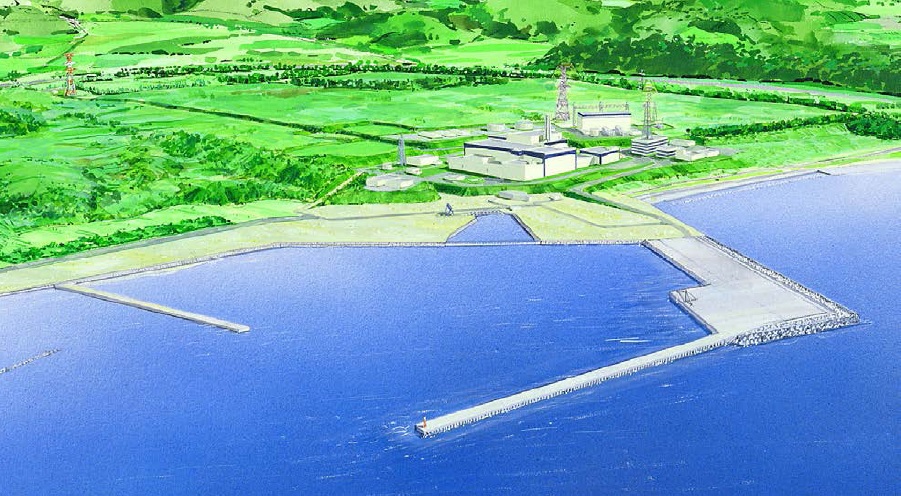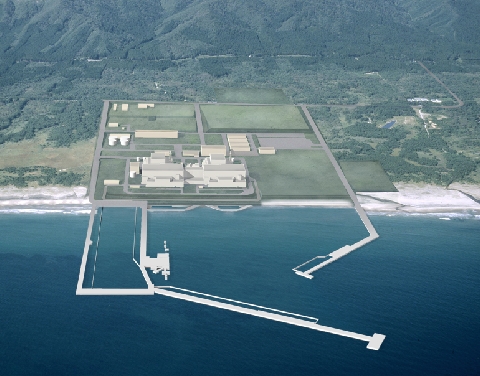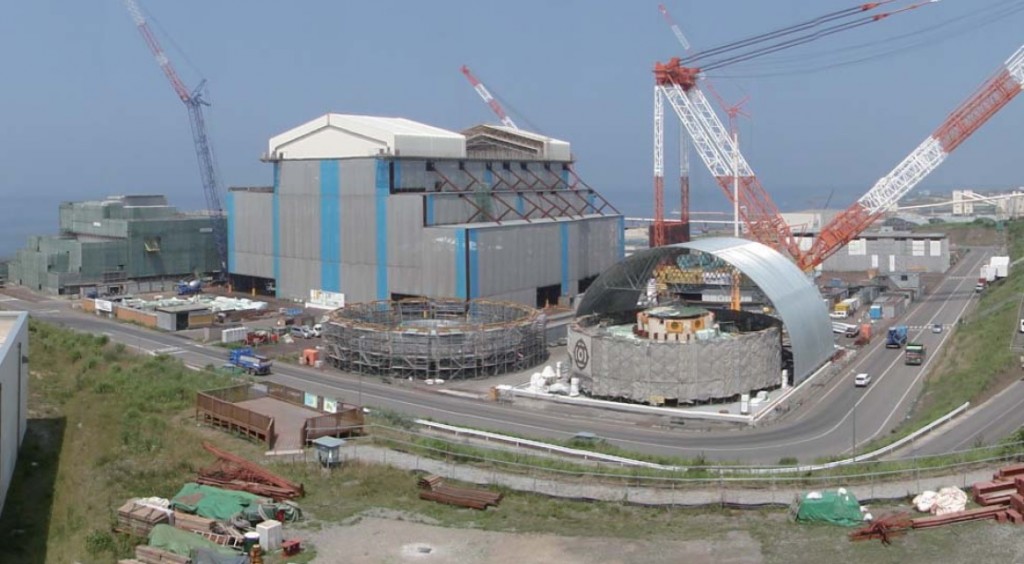What about nuclear startups in Japan?
Media have been abuzz this week following the Reuters' story that attempts to portray the situation of Japanese nuclear power plant restarts as not nearly so rosy as had been hoped. Reuters predicted last year at this time that 14 nuclear plants would restart "in the near term," while this year it predicts seven will do so. This number is difficult to support, because the legal challenges faced by individual plants seem to come and to go. Certainly, those plants that are (or already have been) found to be on or near active faults by Japan's Nuclear Regulation Authority (NRA) are in the deepest trouble.
What has not been mentioned is that there were, at the time of the Great East Japan earthquake and tsunami, three nuclear power plants under construction in Japan. All three of these plants employ the Hitachi-GE ABWR or "Advanced Boiling Water Reactor" design-a design both already tested and proven in operation in Japan for years, and a design that has increased resistance to seismically induced damage by virtue of having major reactor components lower to the ground. Let's take a look briefly at these three projects-which we cannot call "restarts" since they've never operated in the first place.
Chugoku Electric Power Co./Shimane NPP Unit 3
This unit, whose construction was begun in December 2005 (in Japanese terms the "start of construction" usually refers to the first pour of concrete basemat), is actually well over 90 percent complete, and the plant looks like any other finished nuclear power plant. Of all nuclear units under construction in Japan, this is by far the most complete unit-however, its owner has not yet applied to the NRA for the three-pronged set of checks required to start it up. In its 2015 Annual Report, Chugoku states that the company continues to perform site work to ensure that the unit meets the newest, most stringent requirements; it shows a completed seawall (to hold back the waters of tsunami) at least in portion, for example, which is said to be built as proof against 15 meter high tsunami. The plant will also fit watertight doors, and is installing a filtered containment vent.
The company has applied to restart Unit 2 on the same site (an older model) and it is likely that an application will be made for Unit 3, although no timetable for that can presently be given. The company says that it is "drawing up the application"-and that is as specific as it will get on this issue, for the time being, it would appear.
Electric Power Development Co. ("J-Power") Ohma NPP

Ohma NPP, artist's concept- courtesy Electric Power Development Co.
The Ohma nuclear power plant is probably the most visible "under construction" plant in Japan because it is the only one whose owner (commonly known as "J-Power") has applied to start up; the company sent an application for the NRA review in December 2014.
This project has a long, rambling history. The original plan to build a nuclear plant here reaches back to 1976 when the first environmental and site studies were performed; while there was an useless construction application made in 1999, this was withdrawn and later re-issued in March 2004. Permission to begin construction of this single-unit ABWR plant was granted in May 2008. The construction was halted at the time of the quake and tsunami, but in an incredible piece of good news for nuclear power at the time it was announced in October 2012 that construction on the plant had restarted.
The Ohma NPP has received some press in the negative because it is the first plant designed to use a full MOX (mixed-oxide) fuel core. MOX contains plutonium, and has some different characteristics from normal all-uranium fuel. However, the ABWR is designed to use an all MOX core if desired by the owner, and this plant simply fulfills that design specification-and will help to deplete stockpiles of plutonium, which is a goal no one can find wholly objectionable.
The original plan was to have the unit on line in 2012. Even in 2011 when work stopped (for a time) after the quake, the plant was almost 40 percent complete overall; "civil works," which includes ground, general site, and pipe work, were already 64.7 percent complete at that point while construction of structures was 38.5 percent complete and machinery/electrical work was 36.1 percent complete. Late last year, according to WNA, J-Power committed to having the unit completed by 2020 (this must be assumed to include all other relevant site work for quake/tsunami safety, not just the nuclear block construction itself) with commercial operation within two further years.
Tokyo Electric Power Co./Higashidori NPP
This is certainly the most vacuous of the "under construction" nuclear plant project in Japan, as only the site/grounds work has been performed to any extent. In other words, you can tell by looking that this is going to be (or was intended to be) a nuclear plant site, but there's no heavy construction of buildings underway.

Artist's concept of TEPCO Higashidori NPP; courtesy TEPCO.
At the moment, TEPCO's focus (aside from work at Fukushima Daiichi) is to get the only two ABWRs it owns, namely Kashiwazaki-Kariwa-6 and -7, operating again. It has not applied for restart for these units. It continues seismic investigations. As a result of all of its other woes, the Higashidori NPP has received practically no attention.
TEPCO began construction of this plant in January 2011, and halted work at the time of the quake and tsunami only several months later. Given that TEPCO has had to write off about 40 billion yen when it decided some time back to decommission Fukushima Daiichi-5 and -6, and also given that it may indeed be forced to write off more than twice that amount if it is made to decommission the whole Fukushima Daini nuclear plant, it's probably valid to assume that the directors would not authorize the further major expenditures needed to get even the first Higashidori unit built. (Only one unit has been approved for construction at the site; the artist's concept shows what was planned as the final site configuration with two ABWR units.)
The result?
One key for these three projects (well, really two) is that Japan's Ministry of Trade, Economy and Industry has stated in the past that it considers the nuclear plants already authorized ("under construction") as existing, and not as "new," nuclear plants. Therefore, the plants are not affected by policy intended to decrease the nation's percentage of power generated by nuclear (although the quake and tsunami coupled with new regulations will accomplish this reduction by itself). They also are unaffected by any post-Fukushima policies regarding "new nuclear plants."
What the utilities need, in a country that presently appears incurably deficit due to the enormous cost of importing fuels, is a return-even if in a more limited way-to nuclear energy to get money coming back in. Certainly, they need to spend more money now to make it back later. Also, it's important to note that in all instances the Japanese utilities are facing a double-edged sword: At the same time as new requirements and reviews of seismicity may be dooming some of the existing plants, age limits are dooming others. In short, the number of plants even available to upgrade to new standards continues to reduce-and even then those plants still have relatively fixed lifetimes. It's true that a return to nuclear would greatly help Japan vis a vis its power costs-and it's also true that unless new nuclear units are built, return to a better economy would theoretically also have a finite life span.
_________________________________________
 Will Davis is Communications Director and board member for the N/S Savannah Association, Inc. He is a consultant to the Global America Business Institute, a contributing author for Fuel Cycle Week, and writes his own popular blog Atomic Power Review. Davis is also a consultant and writer for the American Nuclear Society, and serves on the ANS Communications Committee. He is a former US Navy reactor operator, qualified on S8G and S5W plants.
Will Davis is Communications Director and board member for the N/S Savannah Association, Inc. He is a consultant to the Global America Business Institute, a contributing author for Fuel Cycle Week, and writes his own popular blog Atomic Power Review. Davis is also a consultant and writer for the American Nuclear Society, and serves on the ANS Communications Committee. He is a former US Navy reactor operator, qualified on S8G and S5W plants.


